While in the Bay Area for the DSL meetup, I went into San Francisco to see the various museum ships around Fisherman's Wharf, joined by cassander and Garrett, with RobRoy and his wife joining us there. There are three different organizations running ships within a few blocks, and it's pretty difficult to figure out what is going on.
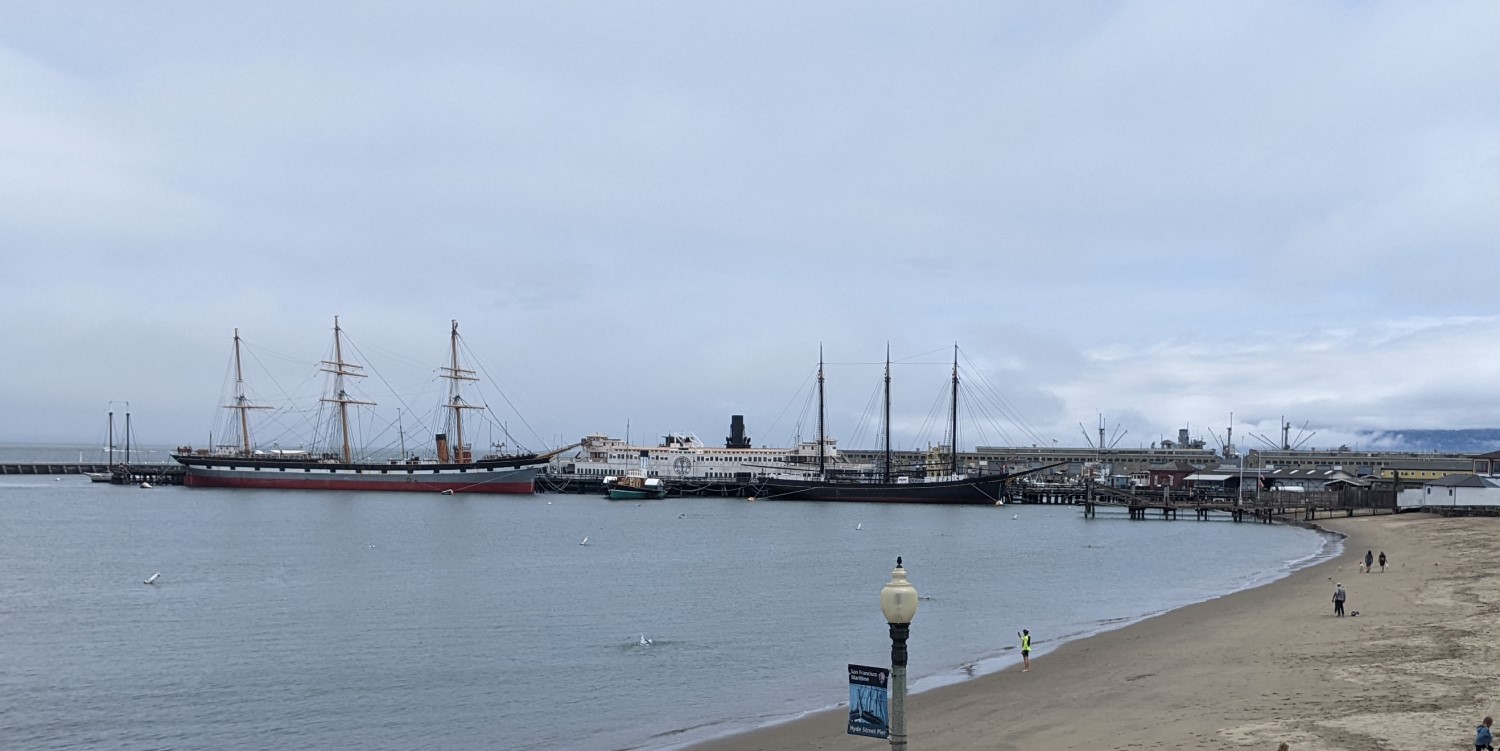
The museum ships from the maritime museum
We started with the San Francisco Maritime National Historic Park, run by the National Park Service. This includes both the San Francisco Maritime Museum, in an old Art Deco building, and the Hyde Street Pier, where there are a number of museum ships reflecting the area's maritime heritage.
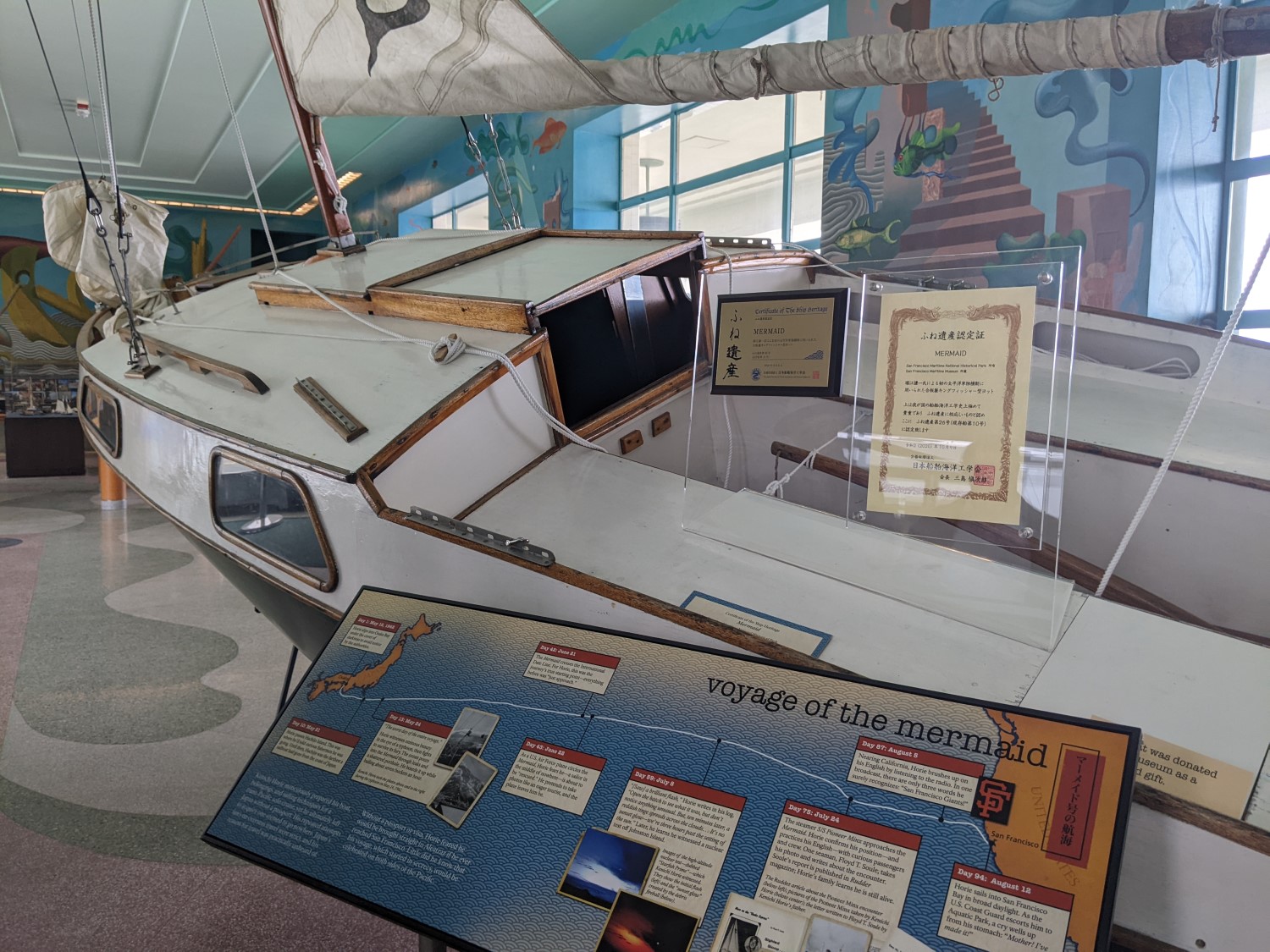
Mermaid, the boat that Kenichi Horie crossed the Pacific with
We started at the maritime museum. It's a pretty building, but there isn't that much stuff in it. I think some of it was closed off when we visited in June 2022, as there was only two small rooms open. The main room had some nice models of various ships and dioramas of scenes from San Francisco's maritime history, along with a few artifacts, but I would classify it as OK at best. The only highlight here was Mermaid, a 19' sailboat used by Japanese yachtsman Kenichi Horie on the first nonstop solo sailing voyage across the Pacific. They had several displays on his voyage, which were interesting, even if they assumed a greater level of knowledge of his voyage than I had going in.
The other room was a collection of maritime photographs, which again wasn't terrible, but also didn't seem great. The space was underused, and given that the park has the largest collection of maritime material on the West Coast, I wasn't sure why they didn't have more stuff on display. The only real upside of the museum was that it was free, and while I am sure there are many better things to do in San Francisco, it's not a terrible way to spend 20-30 minutes.

A prop on display showing extensive cavitation damage
The same cannot be said of the museum ship collection at Hyde Street Pier. This was a disgrace and a waste of a potentially quite interesting collection, to the point where I am almost angry about how the National Park Service has squandered what they have here. It's $15 per person to get in, which means that our group as a whole paid more to get into this than we would have if we'd gone to the Grand Canyon. This isn't an impossible fee to justify (Mystic Seaport costs twice that and felt worth it) but it was in no way reflected in what you got. The signage was sparse, half of the ships were closed to visitors, there was no staff around and the whole thing felt pretty run-down.
The area around the entrance has a number of smaller exhibits, the highlights being a quite pretty triple-expansion engine and a demonstration of a block and tackle that Cassander kept insisting was magic, along with some old buildings and a boat maintenance shed. But even here the signage was lackluster, and things got worse further on.
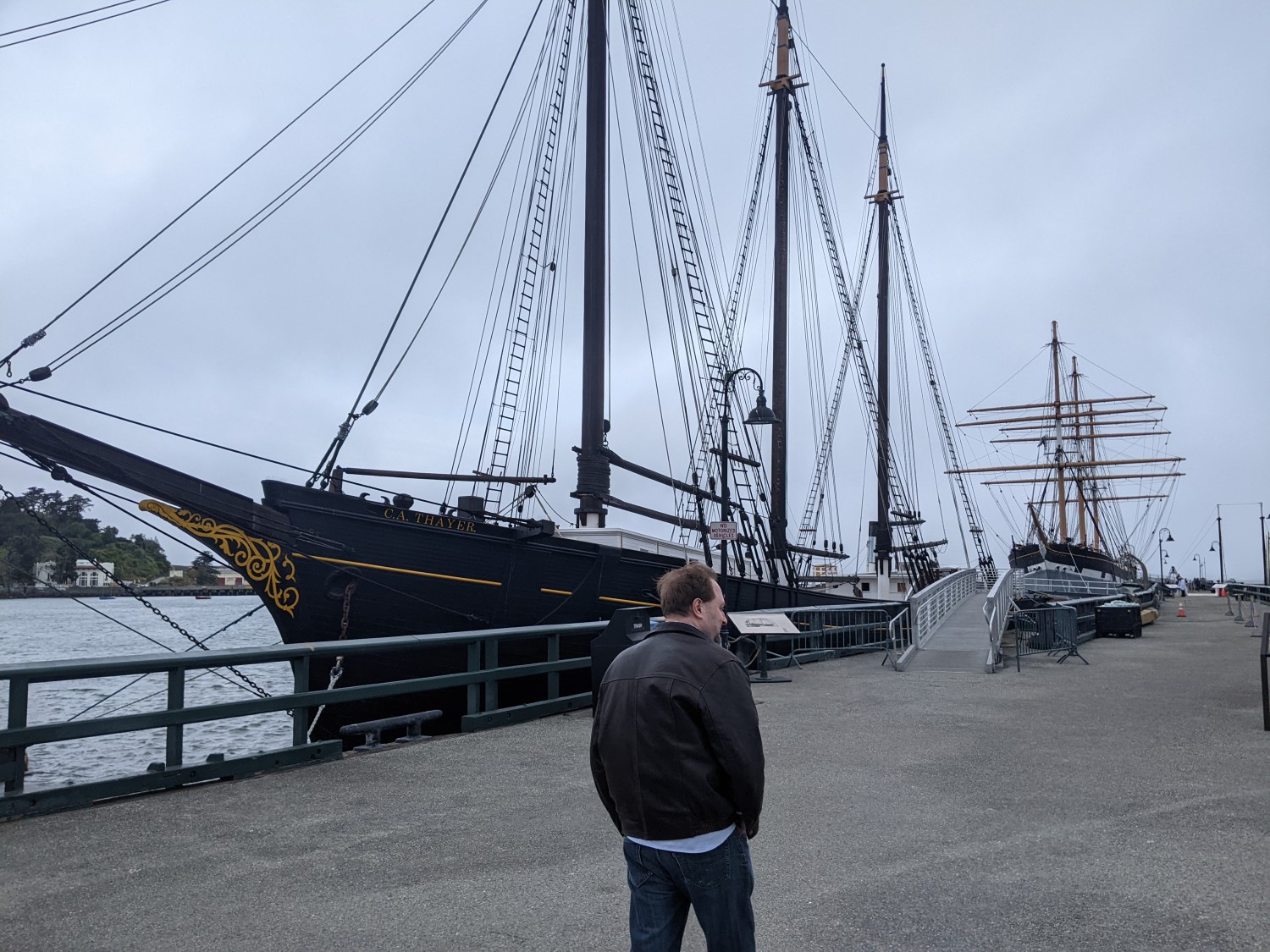
C.A. Thayer (front) and Balclutha
Hyde Street Pier is home to six ships, all built between 1886 and 1914, and covering a variety of different roles, with three sailing transports, two tugs and a ferry. With some decent signage, this could do a good job of telling the broader story of maritime activity around San Francisco. Unfortunately, the signage was not decent, and half of the ships were closed. The highlight of the collection was undoubtedly Balclutha, an iron-hulled square-rigger that spent decades carrying bulk cargoes like grain, lumber and canned salmon during the twilight of sail. She was in decent shape and quite pretty, although only the main deck was open. Signage aboard was almost decent, although still a bit sparse, and there were precious few artifacts on display.
Ahead of Balclutha was C.A. Thayer, a wooden schooner built to carry lumber from the Pacific Northwest to San Francisco that later became a fishing mothership off Alaska, serving in that role until 1950. She was in worse physical shape than Balclutha, and badly needed at least a coat of paint. Again, nothing apart from the main deck was open and the signage was bad, although Cassander and I did go down into the hold, which at least gave an interesting perspective on wooden ship construction.
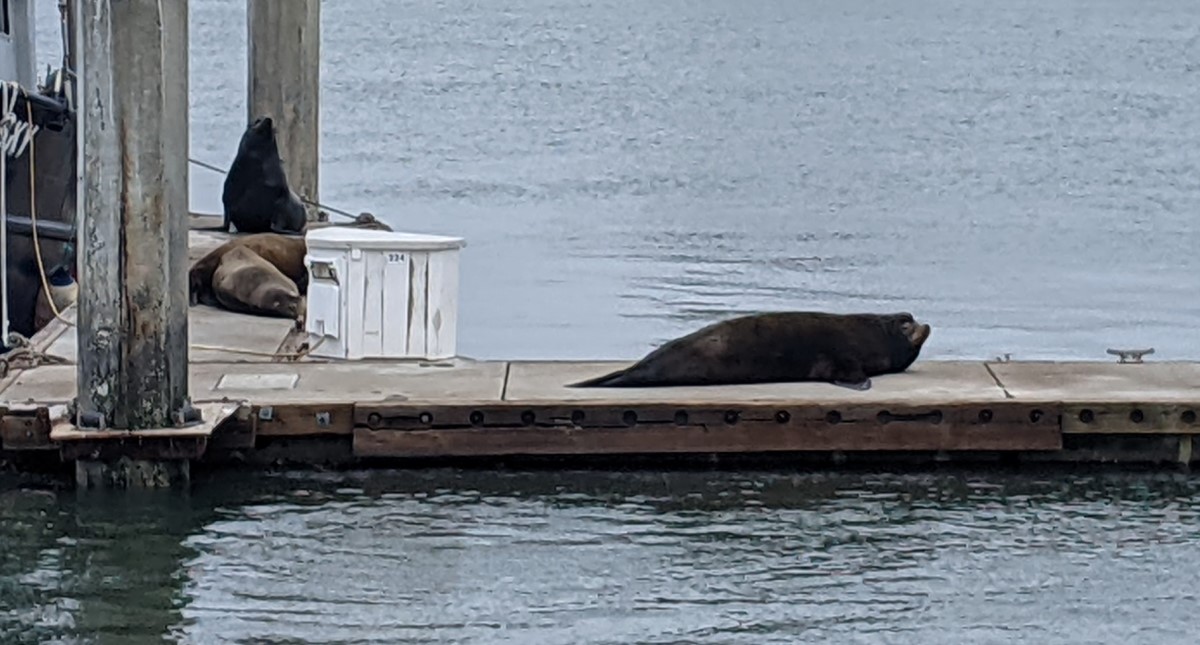
This being San Francisco, we could see some of the local homeless population from Hercules
The last ship that was open was the tug Hercules. To me, she was the most interesting of their ships, as she had a steam engine and a screw. But again, she wasn't in great shape, only the main deck was open, and the signage was quite sparse. That said, it was quite clear that she had been more open in the recent past, with various spaces closed off, probably due to COVID. I am not sure when or if the Park Service will open her back up.
The big ship that wasn't opened up was Eureka, a ferry that had connected the north and south ends of the Golden Gate (the entrance to San Francisco Bay) before the eponymous bridge was completed. She looked to be in quite bad shape, and the barrier keeping us from getting aboard said "closed for the winter". I'm sure she would have been interesting if we'd been allowed aboard, but we sadly were not. Also closed were paddle tug Eppleton Hall and small schooner Alma, along with the museum's collection of small craft. There's also a visitor center across the street, although it seemed to be closed as well.
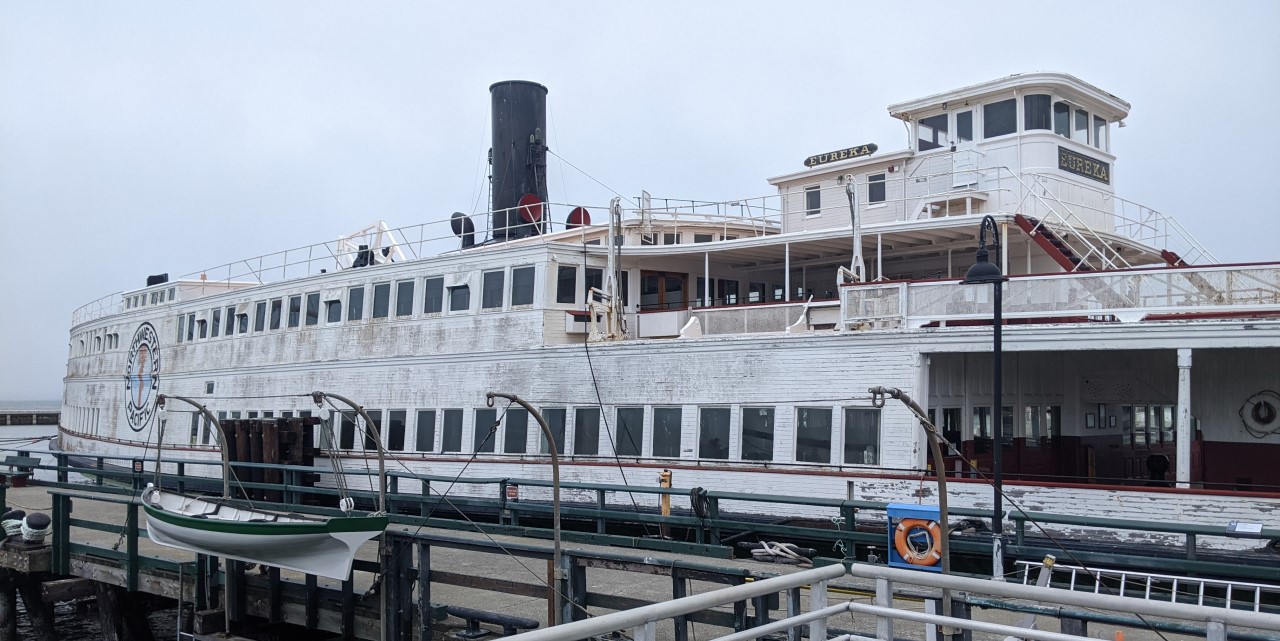
Eureka
In summary, the Hyde Street Pier straight-up isn't worth it. If it cost $5 to go, I'd be annoyed at the wasted potential, but I wouldn't feel like I'd been ripped off. As it is, for the first time I am actively recommending avoiding a nautical museum. Even if you're in the area, don't go unless you can get in much more cheaply than the list price. If nothing else, there's a beach near the entrance where you can swim ashore. The National Park Service should be ashamed of itself. If you're in the area and want to see something maritime, go to Jeremiah O'Brien. If you want something like what this museum should have been, go to San Diego and see the maritime museum there.

Comments
That's really sad. My dad took me there when I was 12ish, and it feels like they had a lot more going on back then. At least somebody has been keeping the ships maintained for the future.
$15 might make sense as a price point for what it probably was 3 years ago. Make sure everything is in good condition, open up the closed stuff and stick a ranger or two there, and I'd probably give it the same "overpriced, but not bad" I gave Pampanito. Obviously, I can't review every place every year (although I can dream), but I'm going to be very reluctant to give them any more money here ever.
In many ways, my biggest concern was that it didn't look like they were doing this. I can understand COVID and it being a Friday (maybe in the school year) impacting the visitor experience. But at the very least, keep the ships up for when the visitors come back.
As a second opinion, I largely agree with Bean. The maritime museum was fine, though there was a lot of wasted potential. It certainly wasn't my cup of tea, but the visit was worthwhile, especially at the price of "free".
The Hyde Street Pier was not. I got in for "free" as the Federal Interagency Annual Pass will get you admission, and I'm not certain it was worth the visit at that price. It was very lackluster. I have far less naval knowledge than Bean, so it should have been easier to keep me entertained. Alas, I was dismayed by the state of maintenance of some of the ships. There were one or two paddle-wheel ships (my terminology may be wrong) and the paddles had rusted/rotted away.
This could have been a great exhibit! Good signage comparing/contrasting the different designs of the different ships would allow people to better appreciate the technological improvements as well as design trade-offs involved in ship usage. Instead, there was far too little guidance for visitors. I didn't know what I was looking at half the time. At least I had Bean to keep me entertained.
How far was this from USS Pampanito and SS Jeremiah O'Brien, at Pier 45?
Also, in tangentially-related news, a couple of months ago I got out to the maritime museum in Morro Bay, California (a small-ish town about halfway between Los Angeles and San Francisco). The museum isn't very big, and its open hours are very limited, but the centerpiece of the collection - the DSRV-2 Avalon - is right out by the street where visitors can walk around it and take pictures.
O'Brien's masts are visible on the right in the top photo. It's about two blocks.